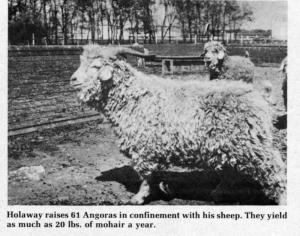Mohair Goats In The North
 ✖  |
Sheep producers have every reason to be envious of Angora goat raisers. Although smaller than sheep, an adult Angora yields an average of $60 worth of mohair each year, about 10 times the value of the average sheep's yearly production.
Until recent years, most Angora goats in the U.S. have been raised in Texas and nearby states, but experience has shown that they'll do just as well "up north".
"The goats don't like cold weather but they survive it very well," says northern Angora producer Dwight Holaway, of Pipestone, Minn. He's been running Angoras with his sheep flock for the last five years. He currently has 55 Angora does and 6 bucks.
"The goats and sheep are housed together in a pole shed that we partially heat to 40? at kidding time. After shearing, the goats are kept warm until new hair grows out," says Holaway.
Angoras are sheared two times a year, and the average adult yields 14 lbs. of hair. Castrated males can yield 18-20 lbs. a year.
Because of Holaway's confinement set-up, the goats produce coarser lower quality mohair than goats on pasture, but they'll produce more hair per goat. Holaway notes that hooves grow more in confinement, so twice-a-year trimming is necessary.
In addition to mohair, there's a market for both goat meat and breeding stock. Males bring $200-250 and does bring about $125 per head. The Holaways have sold breeding stock locally, out west, and to New England.
Says Holaway: "There's no reason why a farmer successful with sheep should not be able to raise Angora goats."
For information contact: FARM SHOW Followup, Dwight Holaway, Rt. 3, Pipestone, Minn. 56164 (ph 507-825-3651).

Click here to download page story appeared in.
Click here to read entire issue
Mohair Goats In The North AG WORLD Ag World 6-3-18 Sheep producers have every reason to be envious of Angora goat raisers. Although smaller than sheep, an adult Angora yields an average of $60 worth of mohair each year, about 10 times the value of the average sheep's yearly production.
Until recent years, most Angora goats in the U.S. have been raised in Texas and nearby states, but experience has shown that they'll do just as well "up north".
"The goats don't like cold weather but they survive it very well," says northern Angora producer Dwight Holaway, of Pipestone, Minn. He's been running Angoras with his sheep flock for the last five years. He currently has 55 Angora does and 6 bucks.
"The goats and sheep are housed together in a pole shed that we partially heat to 40? at kidding time. After shearing, the goats are kept warm until new hair grows out," says Holaway.
Angoras are sheared two times a year, and the average adult yields 14 lbs. of hair. Castrated males can yield 18-20 lbs. a year.
Because of Holaway's confinement set-up, the goats produce coarser lower quality mohair than goats on pasture, but they'll produce more hair per goat. Holaway notes that hooves grow more in confinement, so twice-a-year trimming is necessary.
In addition to mohair, there's a market for both goat meat and breeding stock. Males bring $200-250 and does bring about $125 per head. The Holaways have sold breeding stock locally, out west, and to New England.
Says Holaway: "There's no reason why a farmer successful with sheep should not be able to raise Angora goats."
For information contact: FARM SHOW Followup, Dwight Holaway, Rt. 3, Pipestone, Minn. 56164 (ph 507-825-3651).
To read the rest of this story, download this issue below or click
here to register with your account number.







